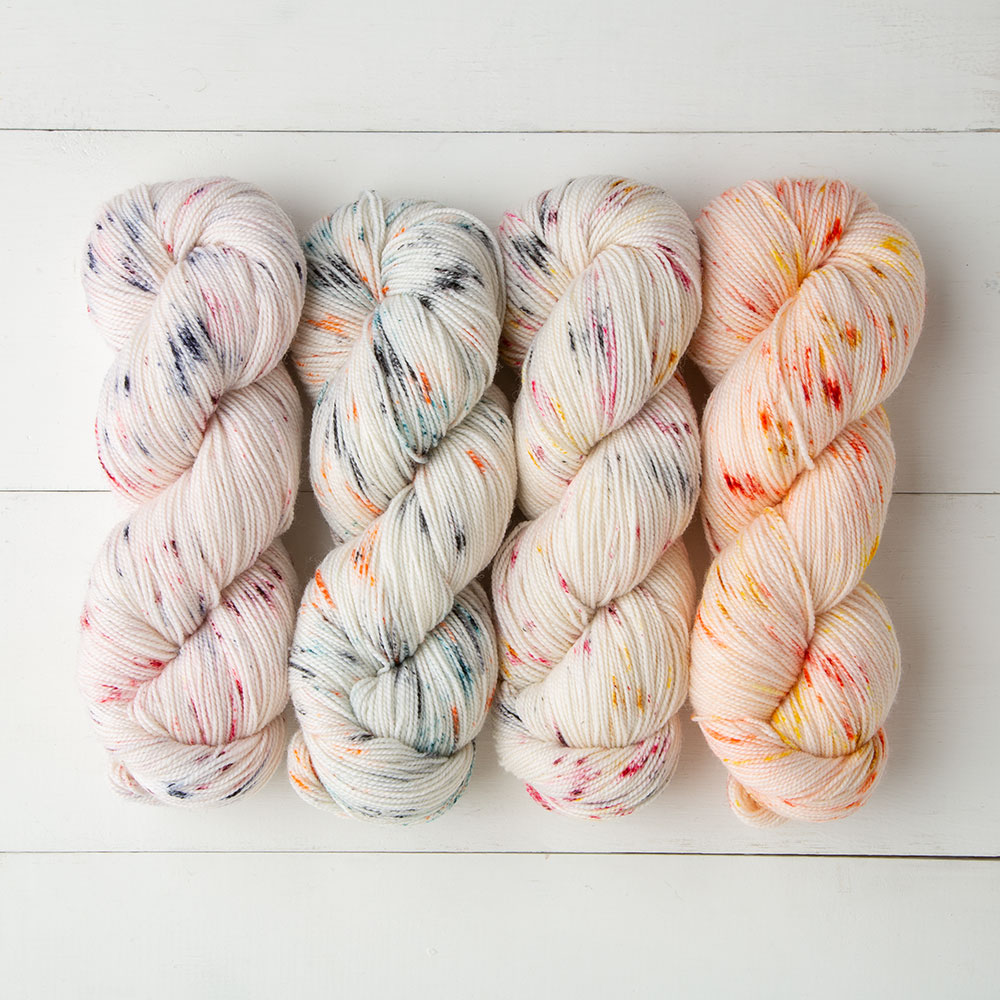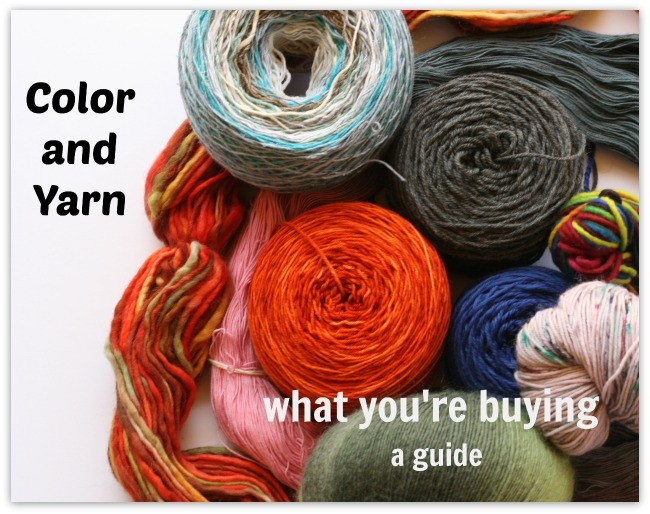Here is a guide that might help the next time you are buying yarn. Its for getting the right color style, the right color design for what you want to make. Not the right color. Not the right shade. I would never presume to try and talk anyone, sight unseen, into which color(s) to buy. No. This guide is to help you understand all the different color styles the makers of yarn offer. I hope it will also help give some idea how these different color styles work up and what they might be good for.
Solids vs. Heathers
A solid color yarn is just what it sounds like. In nearly all cases the fibers were dyed one color, then combed/carded and spun into yarn. If your solid yarn is blue, ever fiber in that yarn is the same shade of blue.
Heathers are often sold as solids and most people will think they are solids until they can take a close look. Heathers are made from fibers in two or more colors. Then those fibers are combed/carded and spun up together. The result is a yarn that has color dimensionality. It will look more alive in shifting, natural light.

The difference is subtle to be sure. In nearly every project that a solid would work, a heather would work as well. Personally I prefer to make fitted garments in heathers because they catch the light a little better, add a little depth, and that helps to flatter my figure (or so I tell myself).
Semi-Soild
A semi-solid yarn is one that has two or more colors that are close, but not exactly, the same. They can also be called tonal. These yarns, more than the others, look like handpainted, hand-crafted yarns. This color style and design is so popular that big yarn companies are coming out with mass-produced versions of this style.
Some semi-solid/tonal yarns are one color applied with different depths of shade to achieve a gentle multi-color effect.

Some semi-solid/tonal yarns are two or more completely different colors that are very close together on the color spectrum.

Whatever method the handdyer used (I’m ignoring the mass-produced variety for as long as I can) the effect is one of slightly shifting colors which the human eye averages into one. Its a very pleasing effect. Semi-solids/tonal look great in lace, cables, and most textured stitch work. They look good in simple stockinette and in stranded-knit colorwork, stripes, color blocks, etc. There is a reason these yarns are so popular.
Variegated
A variegated yarn can also be called a short colorway yarn. That is what you get short stretches of color. Yarn of this type usually has at least three different colors in them and those colors run for just long enough to give you a few stitches before the color changes. These yarns are made and spun in white or a natural off-white. Then they are handpainted (if its hand dyed) or stamped (if its manufactured) with the colors.

Here is a skein that demonstrates very well how it was painted. You can see all three colors and just how long those colors will run. (I couldn’t find a source for this yarn. Its been discontinued. If you like it, you might look into Rowan Fine Art Yarn.)
But most of the time you’ll find variegated yarn looking like this:

The colors were painted on and then it was re-skeined to jumble them up. It makes it a little harder to see what you will get when you work with this yarn, but I can personally attest that re-skeined yarns sell better that those that are not.
All variegated yarns present a challenge… to knitters. If you use it in crochet, particularly crochet lace, you’ll probably be very pleased with the result. Go with a shell or a cluster type stitch and those short runs of color will clump up. In knitting however, variegated yarns usually make terrible lace. Knit stitches don’t clump up very well and any lace pattern is usually lost in all the color changes. Same with cable patterns. Variegated yarns do well in stockinette, garter stitch, seed stitch or slip stitch type patterns. They do well, spectacularly well, when paired with a matching solid.
Self-striping
A self-striping yarn has long stretches of color. So its also called a long color way yarn. The industry standard for these types of yarns is Noro. Nearly every Noro yarn is a long colorway yarn. To makes this style of yarn (in most cases) the raw fibers divided into different batches and each batch is dyed a specific color. Then the fiber is spun by pulling from first one batch, dyed in color A, and then by pulling fiber from the batch dyed color B. The result is feet or maybe even yards of Color A followed by color B. When you work it up you get stripes.

Chroma, which comes in fingering and worsted, is a long color way yarn… but it can be hard to see that with the way its packaged and sold.

Here is some Noro Taiyo in a cake. Its not sold this way either. I just caked it up so you could look and get a better idea of how these yarns would work up.
Long color ways yarns are one of my personal favorites. However, you have to consider how long those color stretches are when planning your project. The length of each color run varies widely between manufacturer. If you only get a few few of each color, that will give you wide stripes in a sock but thin stripes in a blanket. Blankets would need a yarn that gives you yards of each color. Experiment and swatching may be needed.
If you are familiar with entrelac, either the knitted version or the Tunisian crochet version, consider a long-color way yarn for that. The effect can be stunning.
Jacquard
Jacquard yarns are a hybrid of short and long colorway yarns. You get some of both. In these yarns you’ll get some long, stripe forming stretches, and some short (usually VERY short) stretches. Yeah, jacquard yarns are a bit strange.

Jacquard yarn is yarn for cheaters. And I like cheating. While the long stretches form stripes, the short color stretches look like you are doing stranded knit color work.

These yarns make great socks. You blissfully knit along with one ball and you get a sock that looks like you did all kinds of fancy colorwork. As I said, its cheating
Fleck
Fleck yarn is yarn with tiny flecks of color. Its a lesser know, less popular style that handdyers make. These flecks are small, so small that you usually won’t even get a whole stitch in that color.
Here is the only sample I have in my stash. It has flecks and short smears. Those smears might give you a stitch of contrast color. Mostly its a fleck yarn.

When you knit up fleck yarn, you get a base or a background of solid color with sprinkles of color on top. Its a neat effect but you can only see it if you’re making a simple stitch, like stockinette or single crochet. Texture patterns loose the effect. You might get away with a simple lace pattern.
That link above takes you to the company’s site but I can’t see a way to buy the yarn online. So if you’re interested in fleck yarn, take a look at Hawthorn Speckle Handpaint. I haven’t tried the Speckle but Hawthorne is a good line of yarn.

That includes the major yarn color styles on the market. There are others of course but hopefully this will get you started. I also hope it gives you the confidence to buy a yarn that you saw, liked, but weren’t sure how it would look worked up.
Feel free to add advice, thoughts, and shout-outs for your favorite yarns in the comment section. The more we help each other with feedback and information, the more satisfied we will all be with our yarn-buying-happy-fun-time.




"There is no failure. Only feedback." - Robert Allen
16 Comments on "Color and Yarn and what you are buying"
Now I feel the need for some of each.
Yes, I felt the need to go yarn shopping when I was putting this post together. I might need some of that Hawthorn Speckled. But I have a shipment coming in from Knit Picks this week. Hmmm. Should that matter?
How would describe “space dyed”?
That Manos in this post is a spaced dyed yarn.
“Manos Wool Clasica Space Dyed is 100% wool in amazing colors. It works up at 3.5-4.5 stitches per inch making it extremely versatile. The space dyed colors are wonderful combinations that will add beauty to your finished project.”
I think the official definition is “applying multiple colors of dye along a length of yarn.” Basically its what we think of as variegated.
Here is a tutorial with lots of very good pictures demonstration how one handdyer makes a “space-dyed” yarn.
http://www.dharmatrading.com/home/space-dyed-yarn-with-acid-dyes-tutorial.html
HTH!
I’m so glad you explained this! Thank you! Would you explain the significance of the number of plies and how ply relates to size/thickness and how both of these concepts relate to weight?
Great explainations! For some reason I have developed this sudden urge to buy yarn.
Yeah me too. The going through my stash and talking about it all made me think about all the yarns I don’t have. I’m resisting placing an order, but only becasue I ALREADY have an order from Knit Picks coming in this week.
But that doesn’t mean I won’t break and order yarn.
Gosh wow, that’s a lot of information !! I have to admit…most of it I have never even thought about before. That is what makes you a pro Jenn. I would love to know if you do any yarn dying yourself, and if you do, at what point do you dye ?….before or after spinning, and that sort of information. Also, being the young woman that you are, how the heck did you learn so much, and to be so proficient in this wonderful craft ??
If by pro you mean obsessed.. then yes. I’m a “pro”! And I’m not all that young. In in my forties. And on a damp yucky day like we have in Austin today, I’m feeling it.
But I shouldn’t say all that. I should just say ‘aaww shucks” and “thank you!”
Oh and I don’t dye. I have tried it, both ways. I’ve died yarn and I’ve dyed fiber. Let’s see… I’ve dyed fiber all of three times. One was a spectacular failure (all the colors ran together) and the other two times were pretty okay. And I dyed yarn once under the direct supervision of an experience handdyer. lol That came out pretty good.
I just don’t have the space to dye. Its a messy process. Which has not stopped me from buying some yarn dye materials… You know how it is.